ignition Seat Exeo 2010 Owners Manual
[x] Cancel search | Manufacturer: SEAT, Model Year: 2010, Model line: Exeo, Model: Seat Exeo 2010Pages: 319, PDF Size: 9.64 MB
Page 268 of 319

If and when
266Changing the side light bulb (outside of vehicle)
The procedure for changing the bulb is the same on both
sides.
– Switch off the ignition and the lights.
– Raise the bonnet.
– Move the brace ⇒ fig. 196 in the direction of the arrow and
remove the rigid cover, separating the brace side and then
removing the two tabs from the other end of the cover.
– Gently press on the bulb holder tabs ⇒fig. 197 and pull the
cover upwards (it can also be removed by pulling on the bulb
holder wires).
– Separate the bulb from the bulb holder by pulling both pieces anti-clockwise.
– Fit the new bulb by pressing on the bulb holder.
– Insert the bulb into the socket and press on the bulb holder. Fit the cover, first inserting the side tabs and then closing the cover
and the brace. Make sure that the gasket sits well on the casing
cover during the operation.
– Check whether the new bulb is working.
Fig. 196 Side light bulb
(outside of vehicle)Fig. 197 Side light bulb
(outside of vehicle)
A1
exeo_EN.book Seite 266 Montag, 30. August 2010 4:45 16
Page 269 of 319
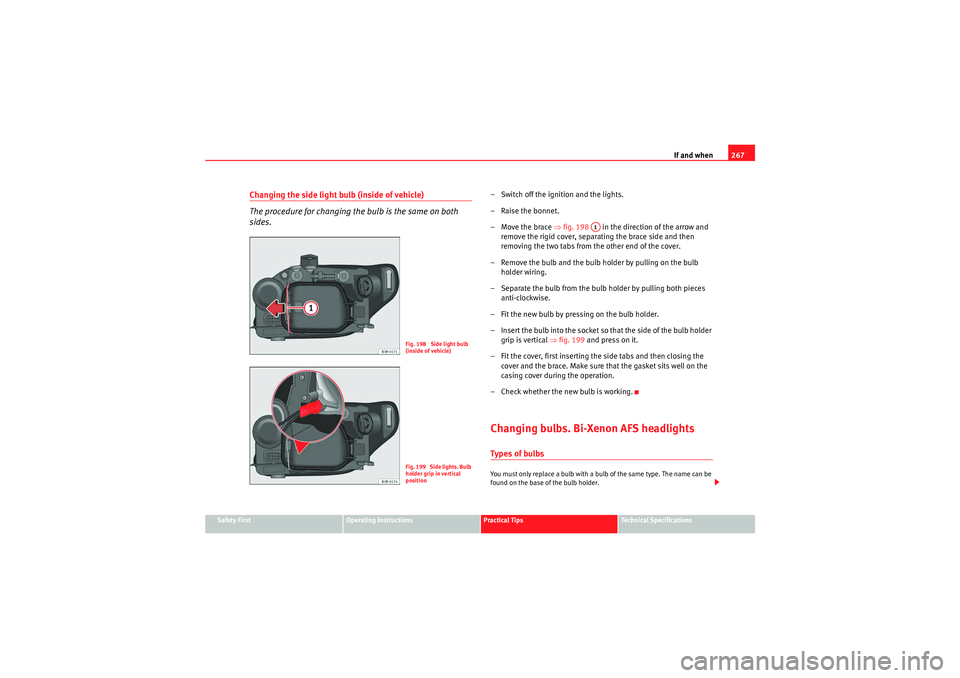
If and when267
Safety First
Operating Instructions
Practical Tips
Technical Specifications
Changing the side light bulb (inside of vehicle)
The procedure for changing the bulb is the same on both
sides.
– Switch off the ignition and the lights.
– Raise the bonnet.
– Move the brace ⇒fig. 198 in the direction of the arrow and
remove the rigid cover, separating the brace side and then
removing the two tabs from the other end of the cover.
– Remove the bulb and the bulb holder by pulling on the bulb holder wiring.
– Separate the bulb from the bulb holder by pulling both pieces anti-clockwise.
– Fit the new bulb by pressing on the bulb holder.
– Insert the bulb into the socket so that the side of the bulb holder grip is vertical ⇒fig. 199 and press on it.
– Fit the cover, first inserting the side tabs and then closing the cover and the brace. Make sure that the gasket sits well on the
casing cover during the operation.
– Check whether the new bulb is working.Changing bulbs. Bi-Xenon AFS headlightsTypes of bulbsYou must only replace a bulb with a bulb of the same type. The name can be
found on the base of the bulb holder.
Fig. 198 Side light bulb
(inside of vehicle)Fig. 199 Side lights. Bulb
holder grip in vertical
position
A1
exeo_EN.book Seite 267 Montag, 30. August 2010 4:45 16
Page 270 of 319
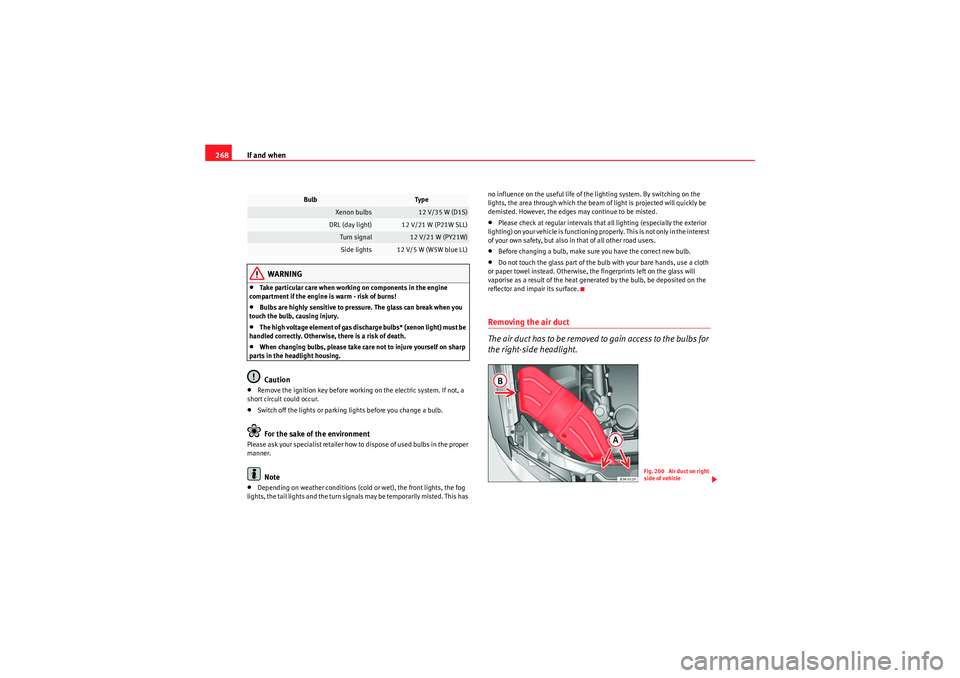
If and when
268
WARNING
•Take particular care when working on components in the engine
compartment if the engine is warm - risk of burns!•Bulbs are highly sensitive to pressure. The glass can break when you
touch the bulb, causing injury.•The high voltage element of gas discha rge bulbs* (xenon light) must be
handled correctly. Otherwise, there is a risk of death.•When changing bulbs, please take care not to injure yourself on sharp
parts in the headlight housing.Caution
•Remove the ignition key before working on the electric system. If not, a
short circuit could occur.•Switch off the lights or parking lights before you change a bulb.For the sake of the environment
Please ask your specialist retailer how to dispose of used bulbs in the proper
manner.
Note
•Depending on weather conditions (cold or wet), the front lights, the fog
lights, the tail lights and the turn signals may be temporarily misted. This has no influence on the useful life of the lighting system. By switching on the
lights, the area through which the beam of light is projected will quickly be
demisted. However, the edges may continue to be misted.
•Please check at regular intervals that all lighting (especially the exterior
lighting) on your vehicle is functioning properly. This is not only in the interest
of your own safety, but also in that of all other road users.•Before changing a bulb, make sure you have the correct new bulb.•Do not touch the glass part of the bulb with your bare hands, use a cloth
or paper towel instead. Otherwise, the fingerprints left on the glass will
vaporise as a result of the heat generated by the bulb, be deposited on the
reflector and impair its surface.Removing the air duct
The air duct has to be removed to gain access to the bulbs for
the right-side headlight.
Bulb
Type
Xenon bulbs
12 V/35 W (D1S)
DRL (day light)
12 V/21 W (P21W SLL)
Turn signal
12 V/21 W (PY21W)
Side lights
12 V/5 W (W5W blue LL)
Fig. 200 Air duct on right
side of vehicle
exeo_EN.book Seite 268 Montag, 30. August 2010 4:45 16
Page 272 of 319
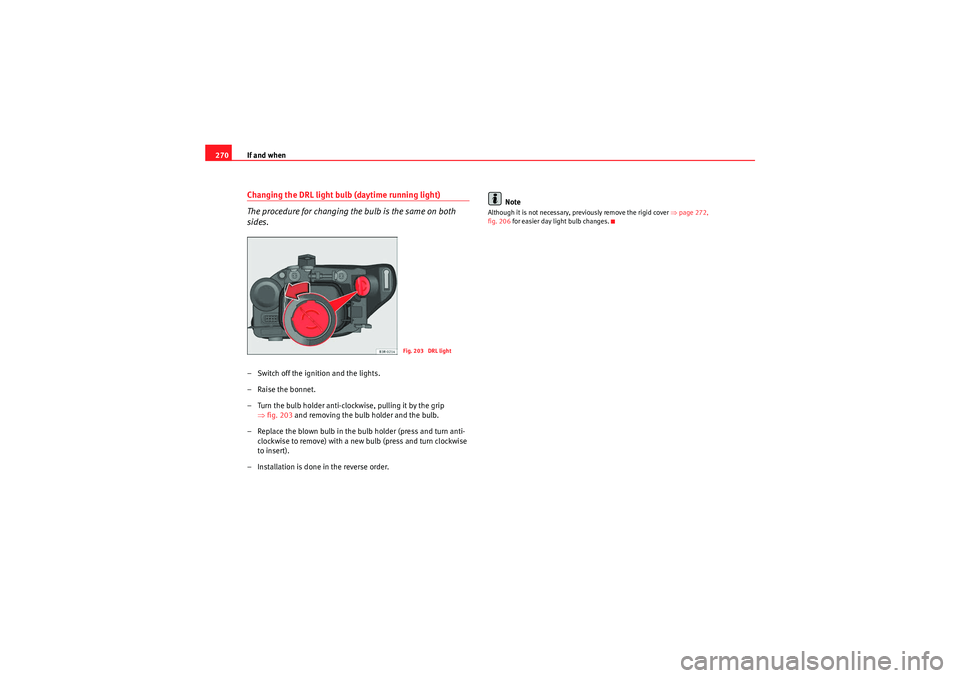
If and when
270Changing the DRL light bulb (daytime running light)
The procedure for changing the bulb is the same on both
sides.– Switch off the ignition and the lights.
– Raise the bonnet.
– Turn the bulb holder anti-clockwise, pulling it by the grip
⇒fig. 203 and removing the bulb holder and the bulb.
– Replace the blown bulb in the bulb holder (press and turn anti- clockwise to remove) with a new bulb (press and turn clockwise
to insert).
– Installation is done in the reverse order. Note
Although it is not necessary, previously remove the rigid cover
⇒page 272,
fig. 206 for easier day light bulb changes.
Fig. 203 DRL light
exeo_EN.book Seite 270 Montag, 30. August 2010 4:45 16
Page 273 of 319

If and when271
Safety First
Operating Instructions
Practical Tips
Technical Specifications
Changing the turn signal bulb
The procedure for changing the bulb is the same on both
sides.
– Switch off the ignition and the lights.
– Raise the bonnet.
– Pull the rubber cap ⇒fig. 204 to remove it.
– Remove the bulb holder by pulling on the grip and turning it anti- clockwise ⇒fig. 205 .
– Replace the blown bulb in the bulb holder (press and turn anti- clockwise to remove) with a new bulb (press and turn clockwise
to insert).
– Insert the bulb holder into the socket with the tab facing upwards and the grip horizontal. Press it against the socket and turn
clockwise. When changing the bulb, you can check the position
of the bulb through the headlight glass.
– Fit the rubber cap and tighten, making sure it fit properly into the headlight casing.
– Check whether the new bulb is working.
Fig. 204 Turn signalFig. 205 Turn signal
exeo_EN.book Seite 271 Montag, 30. August 2010 4:45 16
Page 274 of 319

If and when
272Changing the side light bulb
The procedure for changing the bulb is the same on both
sides.
– Switch off the ignition and the lights.
– Raise the bonnet.
– Move the brace ⇒ fig. 206 in the direction of the arrow and
remove the rigid cover, separating the brace side and then
removing the two tabs from the other end of the cover.
– Remove the bulb holder by pulling on the grip ⇒fig. 207 (it can
also be removed by pulling on the bulb holder wires).
– Separate the bulb from the bulb holder by pulling both pieces anti-clockwise.
– Fit the new bulb by pressing on the bulb holder.
– Insert the bulb into the socket and press on the bulb holder grip.
– Fit the cover, first inserting the side tabs and then closing the cover and the brace. Make sure that the gasket sits well on the
casing cover during the operation.
– Check whether the new bulb is working.Changing the xenon bulbThe procedure for changing the bulb is the same on both sides.
WARNING
This type of bulb should be changed at a qualified workshop.
Fig. 206 Side lightFig. 207 Side light
A1
exeo_EN.book Seite 272 Montag, 30. August 2010 4:45 16
Page 287 of 319

If and when285
Safety First
Operating Instructions
Practical Tips
Technical Specifications
How to jump start: descriptionOn ⇒fig. 230 shows the flat battery and the charged battery.
Jump lead terminal connections
– Switch off the ignition of both vehicles ⇒.
1. Connect one end of the red jump lead to the positive ⇒fig. 230
terminal of the vehicle with the flat battery ⇒.
2. Connect the other end of the red jump lead to the positive terminal in the vehicle providing assistance.
3. Connect one end of the black jump lead to the negative terminal on the battery of the vehicle providing assistance. 4. Connect the other end of the black jump lead to a solid metal
component which is bolted on to the engine block, or onto the
engine block itself of the vehicle with the flat battery. Do not
connect it to a point near the battery ⇒.
5. Position the leads in such a way that they cannot come into contact with any moving parts in the engine compartment.
Starting
6. Start the engine of the vehicle with the boosting battery and let it run at idling speed.
7. Start the engine of the vehicle with the flat battery and wait one or two minutes until the engine is running.
Removing the jump leads
8. Before you remove the jump leads, switch off the headlights (if they are switched on).
9. Turn on the heater blower and heated rear window in the vehicle with the flat battery. This helps minimise voltage peaks which are
generated when the leads are disconnected.
10. When the engine is running, disconnect the leads in reverse order to the details given above.
Connect the battery clamps so they have good metal-to-metal contact with
the battery terminals.
If the engine fails to start, switch off the starter after about 10 seconds and
try again after about half a minute.
Fig. 230 How to connect
the jump leads
AA
AB
A+
A+
A-
AX
exeo_EN.book Seite 285 Montag, 30. August 2010 4:45 16
Page 289 of 319

If and when287
Safety First
Operating Instructions
Practical Tips
Technical Specifications
Towing and tow-startingTo w - s t a r t i n g
The use of jump leads is pr eferable to tow-starting.We recommend that you do not tow-start your vehicle. Jump-starting
is preferable ⇒page 284.
However, if your vehicle has to be tow-started:
– Engage the 2nd or the 3rd gear.
– Keep the clutch pressed down.
– Switch the ignition on.
– Once both vehicles are moving, release the clutch.
– As soon as the engine starts, press the clutch and move the gear lever into neutral. This helps to prevent driving into the towing
vehicle.
WARNING
The risk of accidents is high when tow-starting. The vehicle being towed
can easily collide with the towing vehicle.
Caution
When tow-starting, fuel could enter the catalytic converter and damage it.
General notesPlease observe the following po ints if you use a tow-rope:
Notes for the driver of the towing vehicle
– Drive slowly at first until the tow-rope is taut. Then accelerate gradually.
– Begin and change gears cautiously. If you are driving an auto- matic vehicle, accelerate gently.
– Remember that the brake servo and power steering are not working in the vehicle you are towing. Brake earlier than you
would normally, but with a more gentle pressure on the brake.
Notes for the driver of the towed vehicle
– Ensure that the tow-rope remains taut at all times when towing.Tow-rope or tow-bar
It is easier and safer to tow a vehicle with a tow-bar. You should only use a
tow-rope if you do not have a tow-bar.
A tow-rope should be slightly elastic to reduce the loading on both vehicles.
It is advisable to use a tow-rope made of synthetic fibre or similarly elastic
material.
Attach the tow-rope or the tow-bar only to the towing eyes provided or a
towing bracket.
Driving style
Towing requires some experience, especially when using a tow-rope. Both
drivers should be familiar with the technique required for towing. Inexperi-
enced drivers should not attempt to tow-start or tow away another vehicle.
exeo_EN.book Seite 287 Montag, 30. August 2010 4:45 16
Page 290 of 319
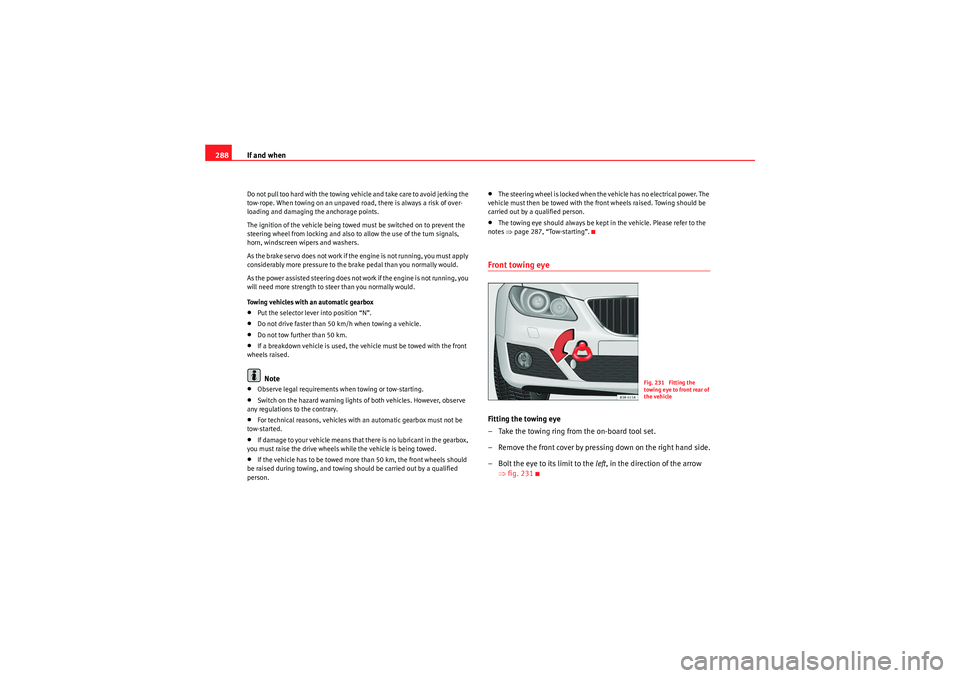
If and when
288Do not pull too hard with the towing vehicle and take care to avoid jerking the
tow-rope. When towing on an unpaved road, there is always a risk of over-
loading and damaging the anchorage points.
The ignition of the vehicle being towed must be switched on to prevent the
steering wheel from locking and also to allow the use of the turn signals,
horn, windscreen wipers and washers.
As the brake servo does not work if the engine is not running, you must apply
considerably more pressure to the brake pedal than you normally would.
As the power assisted steering does not work if the engine is not running, you
will need more strength to steer than you normally would.
Towing vehicles with an automatic gearbox•Put the selector lever into position “N”.•Do not drive faster than 50 km/h when towing a vehicle.•Do not tow further than 50 km.•If a breakdown vehicle is used, the vehicle must be towed with the front
wheels raised.Note
•Observe legal requirements when towing or tow-starting.•Switch on the hazard warning lights of both vehicles. However, observe
any regulations to the contrary.•For technical reasons, vehicles with an automatic gearbox must not be
tow-started.•If damage to your vehicle means that there is no lubricant in the gearbox,
you must raise the drive wheels while the vehicle is being towed.•If the vehicle has to be towed more than 50 km, the front wheels should
be raised during towing, and towing should be carried out by a qualified
person.
•The steering wheel is locked when the vehicle has no electrical power. The
vehicle must then be towed with the front wheels raised. Towing should be
carried out by a qualified person.•The towing eye should always be kept in the vehicle. Please refer to the
notes ⇒page 287, “Tow-starting”.Front towing eyeFitting the towing eye
– Take the towing ring from the on-board tool set.
– Remove the front cover by pressing down on the right hand side.
– Bolt the eye to its limit to the left, in the direction of the arrow
⇒ fig. 231
Fig. 231 Fitting the
towing eye to front rear of
the vehicle
exeo_EN.book Seite 288 Montag, 30. August 2010 4:45 16
Page 309 of 319
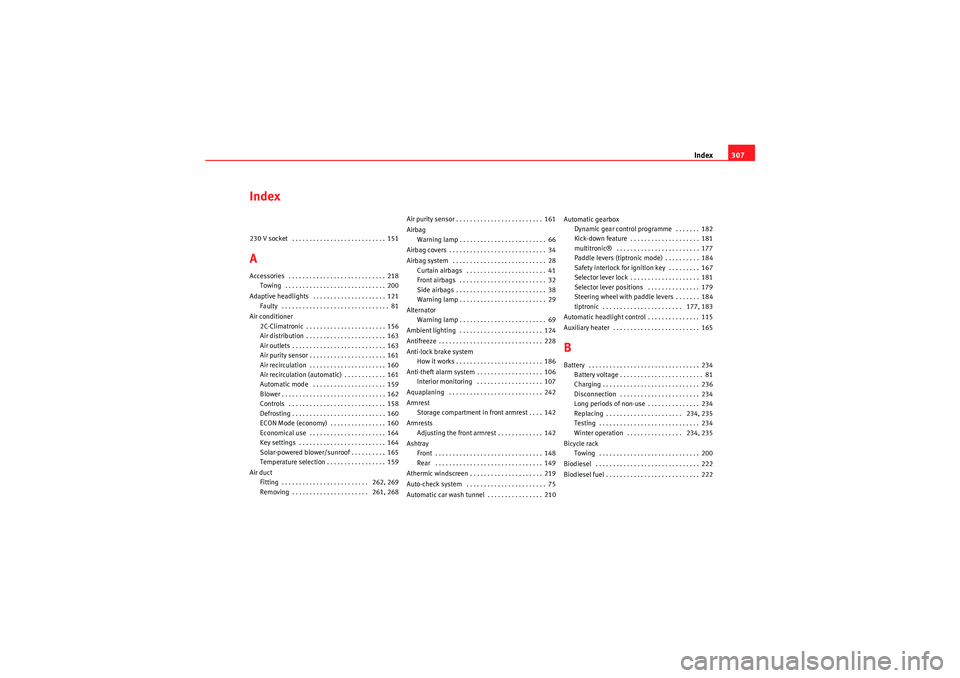
Index307
Index230 V socket . . . . . . . . . . . . . . . . . . . . . . . . . . . 151AAccessories . . . . . . . . . . . . . . . . . . . . . . . . . . . . 218
Towing . . . . . . . . . . . . . . . . . . . . . . . . . . . . . 200
Adaptive headlights . . . . . . . . . . . . . . . . . . . . . 121 Faulty . . . . . . . . . . . . . . . . . . . . . . . . . . . . . . . 81
Air conditioner 2C-Climatronic . . . . . . . . . . . . . . . . . . . . . . . 156
Air distribution . . . . . . . . . . . . . . . . . . . . . . . 163
Air outlets . . . . . . . . . . . . . . . . . . . . . . . . . . . 163
Air purity sensor . . . . . . . . . . . . . . . . . . . . . . 161
Air recirculation . . . . . . . . . . . . . . . . . . . . . . 160
Air recirculation (automatic) . . . . . . . . . . . . 161
Automatic mode . . . . . . . . . . . . . . . . . . . . . 159
Blower . . . . . . . . . . . . . . . . . . . . . . . . . . . . . . 162
Controls . . . . . . . . . . . . . . . . . . . . . . . . . . . . 158
Defrosting . . . . . . . . . . . . . . . . . . . . . . . . . . . 160
ECON Mode (economy) . . . . . . . . . . . . . . . . 160
Economical use . . . . . . . . . . . . . . . . . . . . . . 164
Key settings . . . . . . . . . . . . . . . . . . . . . . . . . 164
Solar-powered blower/sunroof . . . . . . . . . . 165
Temperature selection . . . . . . . . . . . . . . . . . 159
Air duct Fitting . . . . . . . . . . . . . . . . . . . . . . . . . 262, 269
Removing . . . . . . . . . . . . . . . . . . . . . . 261, 268 Air purity sensor . . . . . . . . . . . . . . . . . . . . . . . . . 161
Airbag
Warning lamp . . . . . . . . . . . . . . . . . . . . . . . . . 66
Airbag covers . . . . . . . . . . . . . . . . . . . . . . . . . . . . 34
Airbag system . . . . . . . . . . . . . . . . . . . . . . . . . . . 28 Curtain airbags . . . . . . . . . . . . . . . . . . . . . . . 41
Front airbags . . . . . . . . . . . . . . . . . . . . . . . . . 32
Side airbags . . . . . . . . . . . . . . . . . . . . . . . . . . 38
Warning lamp . . . . . . . . . . . . . . . . . . . . . . . . . 29
Alternator Warning lamp . . . . . . . . . . . . . . . . . . . . . . . . . 69
Ambient lighting . . . . . . . . . . . . . . . . . . . . . . . . 124
Antifreeze . . . . . . . . . . . . . . . . . . . . . . . . . . . . . . 228
Anti-lock brake system How it works . . . . . . . . . . . . . . . . . . . . . . . . . 186
Anti-theft alarm system . . . . . . . . . . . . . . . . . . . 106 Interior monitoring . . . . . . . . . . . . . . . . . . . 107
Aquaplaning . . . . . . . . . . . . . . . . . . . . . . . . . . . 242
Armrest Storage compartment in front armrest . . . . 142
Armrests Adjusting the front armrest . . . . . . . . . . . . . 142
Ashtray Front . . . . . . . . . . . . . . . . . . . . . . . . . . . . . . . 148
Rear . . . . . . . . . . . . . . . . . . . . . . . . . . . . . . . 149
Athermic windscreen . . . . . . . . . . . . . . . . . . . . . 219
Auto-check system . . . . . . . . . . . . . . . . . . . . . . . 75
Automatic car wash tunnel . . . . . . . . . . . . . . . . 210 Automatic gearbox
Dynamic gear control programme . . . . . . . 182
Kick-down feature . . . . . . . . . . . . . . . . . . . . 181
multitronic® . . . . . . . . . . . . . . . . . . . . . . . . 177
Paddle levers (tiptronic mode) . . . . . . . . . . 184
Safety interlock for ignition key . . . . . . . . . 167
Selector lever lock . . . . . . . . . . . . . . . . . . . . 181
Selector lever positions . . . . . . . . . . . . . . . 179
Steering wheel with paddle levers . . . . . . . 184
tiptronic . . . . . . . . . . . . . . . . . . . . . . . 177, 183
Automatic headlight control . . . . . . . . . . . . . . . 115
Auxiliary heater . . . . . . . . . . . . . . . . . . . . . . . . . 165
BBattery . . . . . . . . . . . . . . . . . . . . . . . . . . . . . . . . 234 Battery voltage . . . . . . . . . . . . . . . . . . . . . . . . 81
Charging . . . . . . . . . . . . . . . . . . . . . . . . . . . . 236
Disconnection . . . . . . . . . . . . . . . . . . . . . . . 234
Long periods of non-use . . . . . . . . . . . . . . . 234
Replacing . . . . . . . . . . . . . . . . . . . . . . 234, 235
Testing . . . . . . . . . . . . . . . . . . . . . . . . . . . . . 234
Winter operation . . . . . . . . . . . . . . . . 234, 235
Bicycle rack Towing . . . . . . . . . . . . . . . . . . . . . . . . . . . . . 200
Biodiesel . . . . . . . . . . . . . . . . . . . . . . . . . . . . . . 222
Biodiesel fuel . . . . . . . . . . . . . . . . . . . . . . . . . . . 222
exeo_EN.book Seite 307 Montag, 30. August 2010 4:45 16